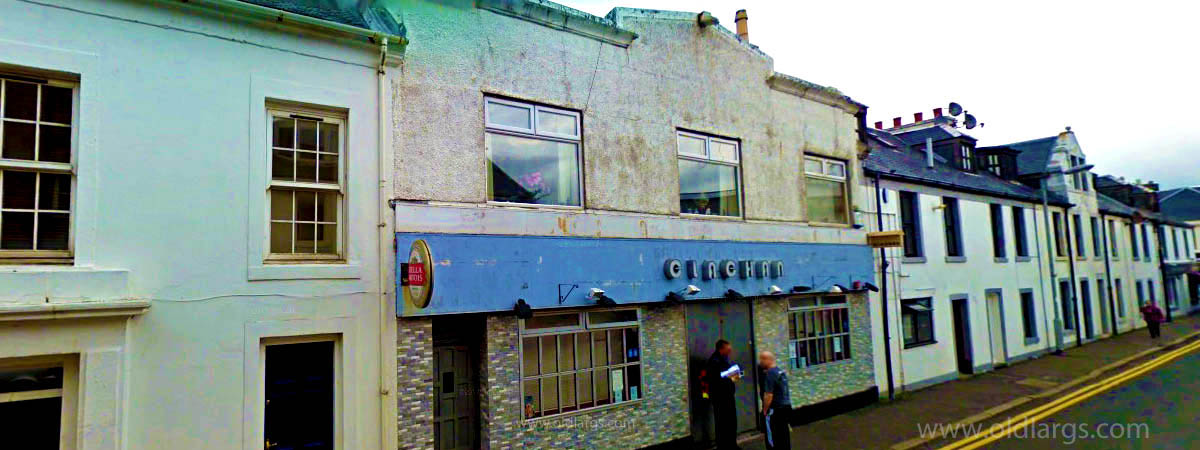
Bath Street to the Pencil walk.
In this feature we will start at the entrance to Bath Street, then head over to Mackerston, up Castle Hill to Boomfields, then travel to the pencil via Bowen Craig. We hope you enjoy this historical guided walk and learn a wee bit more about the amazing history of our wee town of Largs.Bath Street.
On the left as we enter Bath Street is Wilkies ladies fashion store. There has been a building on this spot since 1850 when it was Gloag Tailors. Much later is was home to Lawson's store ,ran by Jimmy Lawson, and by 1997 Wilkies.
Further up on the left we have a few empty retail units which used to hold the Ayrshire Cancer Support Shop. Next door at number 18 was the Steamie Laundrette for many years At the end of the block was Broomlands Furnishings which closed in 1994, then Weir Carpets until 1990. Later it was home to a Complimentary Health Shop and until recently a Mobility and Wellbeing Centre shop. Sadly it is now empty.
On the right of Bath Street we have a row of 2 storey buildings built in the 1850s which end at the Waterside Pub. There has been a public house on the site of the Waterside Pub since 1855 when it was called the Star Inn.. More recent names for earlier pubs were the Suez Canal Bar and then the fondly remembered and popular Clachan Bar. Prior to the new Largs Prom flood defences being built, the Suez Canal and the Clachan, along with most of Bath street, were flooded regularly during storms. The pub having a back door leading directly to the prom did not help matters. Many a customer were stranded in the pub during these floods which to be honest is not a bad place to be stranded in such an event. Ironically the bar decor of the old Suez Canal bar was shaped like the bow of a ship so never looked out of place during a pub flood.The Clachan was a very popular Largs watering hole in its day. Ran by Mr & Mrs Hannah then Charlie Lyle in the 70s and 80s. During one memorable Bath Street flood Charlie Lyle collected customers from Robert F Duff [then The Bank of Scotland] with his yacht's dinghy and rowed then to the front door. Now that is what you call good customer service.
Moving on from the Waterside the tenement seen today were built in 1892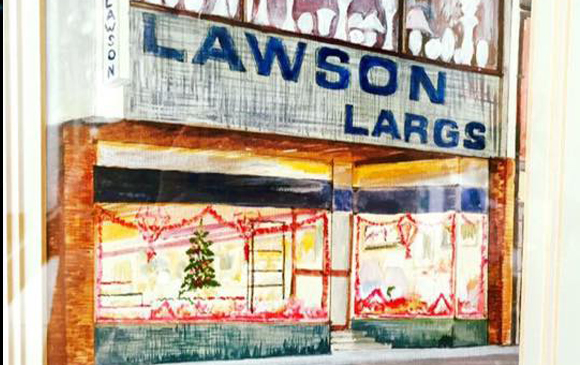
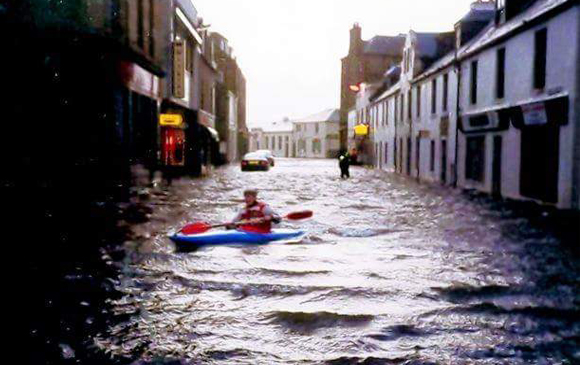
An old Advert drawing of Lawsons, now Wilkies.
Bath Street flooded. A regular sight prior to the flood defences being installed.
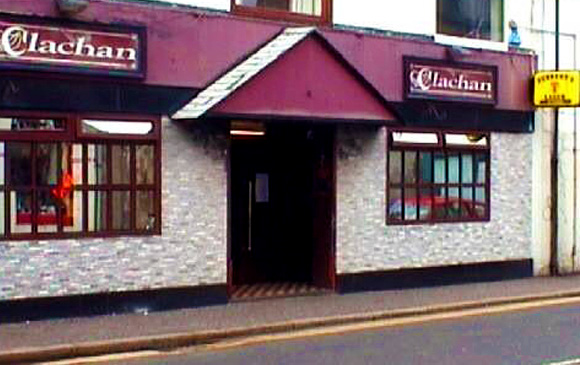
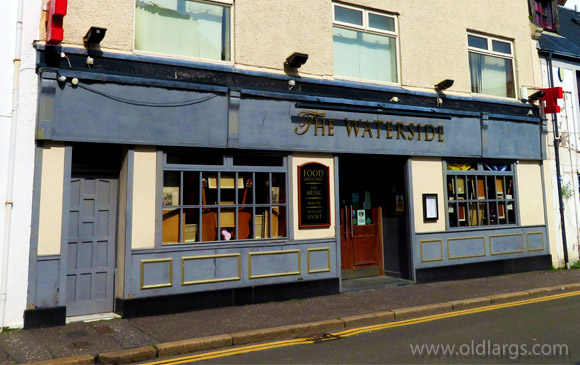
The Old Clachan Bar. An extremely popular bar with locals in its day.
The Waterside as it is today.
The Brisbane Centre and Green Shutters.
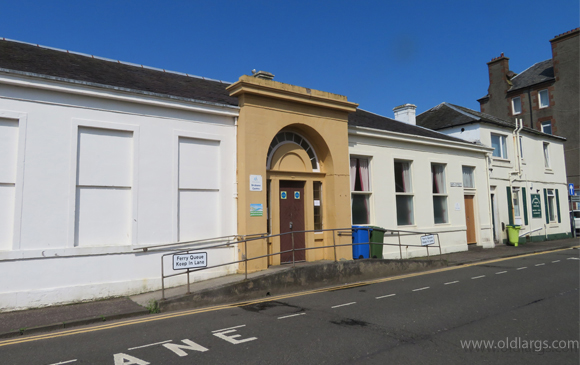
The land which the Brisbane Centre sits on today and the extended area to the foreshore was once known as the Common of Largs. It was used for the pasture of animals.
At one time the only building here was the coach house and stables of John Crichton-Stuart ,the 2nd Marquess of Bute. He left his carriage and horses at Largs when he
crossed to his estate at Mount Stuart.
The early 1800s seen the emergence of public baths for cleaning, and not for swimming. In June 1816 the first public baths in Largs opened after £2000 was raised by public subscription. The building which later become today's Brisbane Centre contained hot, cold, vapour and spray baths, a billiard room, library and large coffee room. A caretaker’s house was built next door which would later become the Green Shutter’s tearoom. Later in the 1870s when the baths fell out of fashion the building was converted into halls where the Justice of Peace Courts and public meetings were held.
In the 1930s it was used as a roller skating rink and was ran by Robert Nixon and John Kelso from Saltcoats. This was very popular for about one year then its interest waned and the rink was closed. They then introduced crazy golf to the hall but this never took off.Bath Hall was then acquired by William Harper and remained in the possession of his family until 1936 when it was gifted to the local branch of the Christian Movement ToC H. During World War II it was used by servicemen as a place to relax and meet with friends. In October 1941 the Toc H extended their facilities by erecting a wooden structure in Fort Street. During this time the hall was also used as a dance hall. This structure was demolished In April 1946.
By 1942 Ayr County Council had leased the south hall and used it to hold Largs Public Library. By 1954 the building was put up for sale by the Toc H as they could not afford roof repairs. Ayr County Council bought the library portion in July of 1955 and later and later installed toilets for the staff. In 1983, a new library was built in Allanpark Road and the hall was refurbished by Cunningham District Council to become a community centre.Today the south hall is the Brisbane Centre however Toc H still retain the smaller north hall as their own. The hall still serves the community and holds many local community and various club events.
The Green shutters building was original the caretaker’s house built next door to the original Baths. Later it was ran as an ice-cream shop and tearoom by Miss Harper, a niece of David Harper. It then passed into Toc H ownership in 1938 who eventually sold it in 1964 to Miss Murdoch and her nephew Dan Wilson. The front extension was added in the 1960s. Today the Green Shutters is popular as ever with its open views across to Cumbrae and it lovely outside sitting area.
The Brisbane Centre entrance from Bath Street.
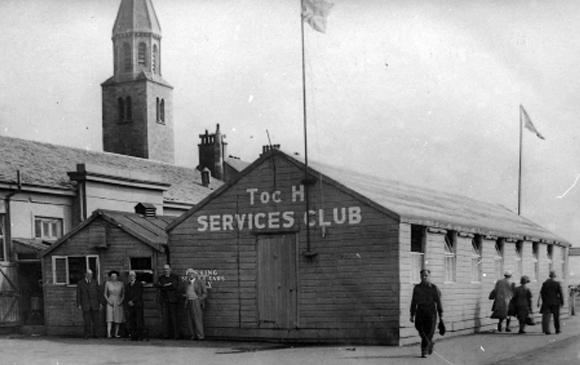
The Toc H Service Club hut.
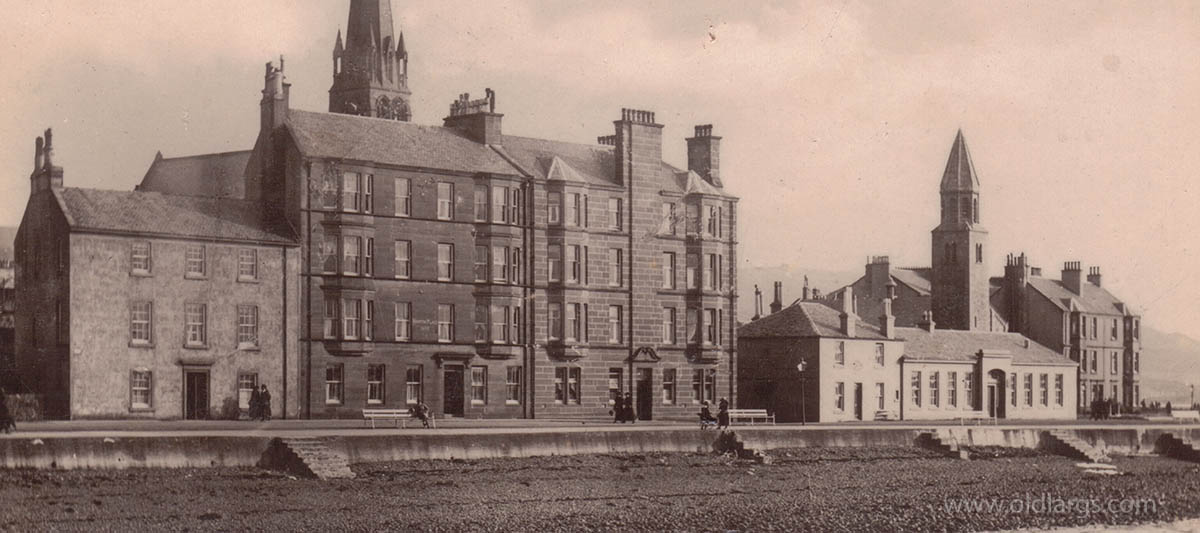
Clark Memorial Church.
The Clark Memorial congregation had its origins in 1780 in a thatched building. They then moved to a new church in Waterside Street before moving to the present site. The church in Waterside still stands today and is currently the home to the Narducci Auction Room.
The congregation eventually merging with other denominations to form the United Secession Synod. By 1847 they were the United Presbyterian Church. It was for this congregation that the Clark Memorial church was built. The name changed again in 1900 after a union with the Free Church which formed the United Free Church. Finally in 1929 they reunited with the established Church of Scotland and Clark Memorial assumed the full status of a Parish Church.
Clark Memorial Church of Scotland was donated in its entirety by John Clark who lived at the Curlinghall mansion at Broomfeilds. This building would later becomepart of the Marine and Curling Hall Hotel. He was the senior partner of the Anchor Thread Mills in Paisley and former provost of Largs.Work began in 1889 and cost £30,000. The site chosen was directly adjacent to the St Johns Free Church. That congregation offered no objection. Seating was for 742. In 1966 the new church hall was opened.
The church building was designed by William Kerr who was about 23 years of age at the time. It is built of red sandstone from Locharbriggs and Corsehill in Early English Gothic style. It is a seven bay church with buttresses, a single aisle to the north and a 160 foot, three stage tower and spire, a session room (now the church office) and four bay hall to the southeast. The church is a category A listed building. In 2019, a number of alterations were made to the interior of the church. This was part of a larger conservation project supported by Historic Environment Scotland and the National Lottery Heritage Fund.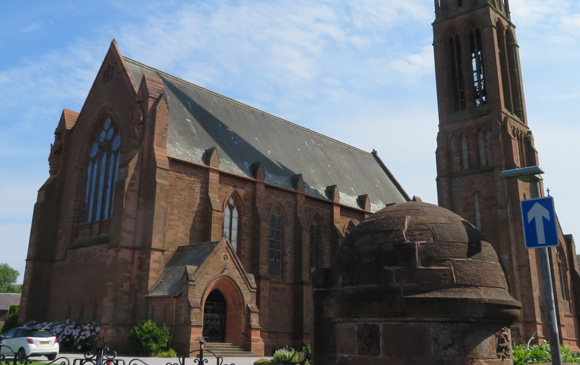
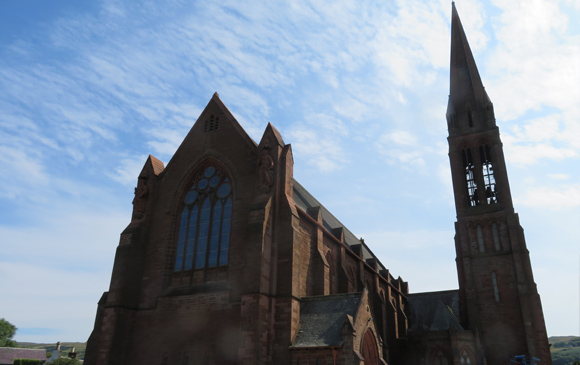
The Clark Memorial Church built 1889.
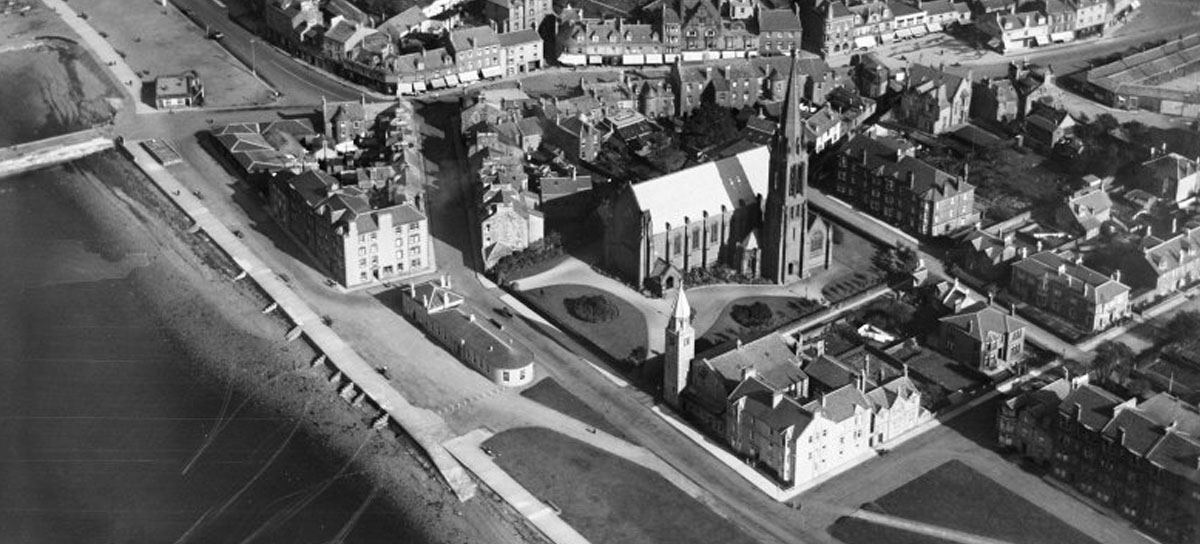
A photo of the Bath Street area taken prior to 1936. The Moorings Ballroom was yet to be built by the Castelvecchi's and their original wooden cafe buildings can be seen in the photo.
St John's Church.
The origins of the congregation of St John's Largs lie in the formation of the free Church of Scotland following the disruption of 1843. The Disruption of 1843 was a bitter nationwide division which split the established Church of Scotland into smaller churches.
Shortly after this event The Rev John Dow of the Parish Church in Largs, along with two hundred members of his congregation, established the Free Church in Largs.
The foundation stone for the Largs Free Church was laid on 28th September 1843. The original building was very different from today’s structure. It was a small simple building consisting of four whinstone walls and a bell tower. Some of the stones used in its construction were from an old GoGo burn mill which was demolished earlier in 1837.In 1886, plans were submitted for the reconstruction of the church. The architect was Archibald J Grahame who sadly died with malaria before building work on the church commenced. The new church was built in the French Romanesque style. The whinstone north, east and south walls of the original church were retained. The church tower was designed with Italian architecture in mind.
The new church was known as Largs Free Church until after the union of the Free and United Presbyterian Churches in 1900 which then created the United Free Church of Scotland. The building became known as St John's Church after the reconstruction. At that time the minister was Dr Charles Watson. Because of Dr Watson's love for St John as a new Testament writer, the Free Church congregation displayed their respect for their minister by giving the name St John to the Church.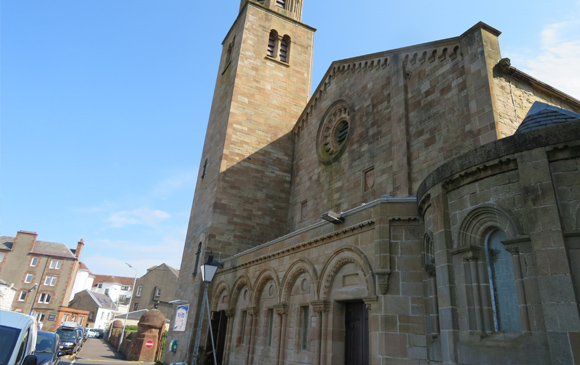
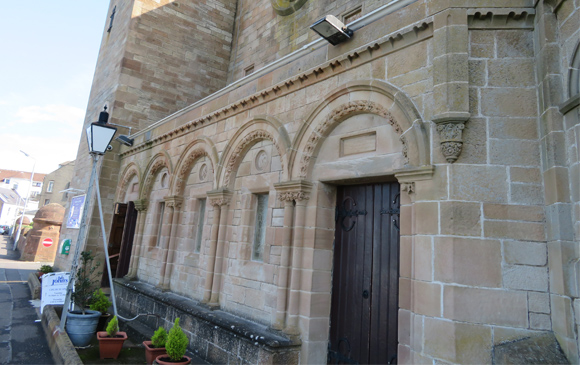
Originally the Largs Free Church the construction of St Johns started on 1843
Designed by architect Archibald J Grahame who sadly died before the building was completed.
